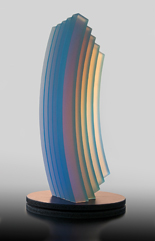Chronology of Work
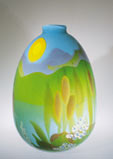
Early works 1967 – 1977
Develops blowing skills, designs and builds various furnaces and equipment, develops formulations for crystal, various opal and luster glasses. Produces iridescent miniatures, gather pots, flower forms, spaghetti bowls, copper core vessels, opaque geometric and image vessels.
Swampscape 2, Opaque Image Vessel, OP 19, 1975, blown glass, cased, layered hot tooled opal and murini application, 13.875 x 9.5 x 9.5 inches. Collection of Martha Jane Peiser. Photo: © Martha Jane Peiser

Paperweight Vases (PWV) 1975 – 1981
Introduces and develops torch working techniques for furnace blown work allowing more detailed imagery and perspective. Produces Paperweight Vases portraying natural subjects and landscapes, urban views and abstract imagery related to the vessel form.
Behind Uncle Buddy’s House, Paperweight Vase, PWV 139, 1978, blown glass, cased, layered torch work imagery, 8 x 8.75 x 8.75 inches. Collection of Dr. and Mrs. Simon Fredricks. Photo: © Ann Hawthorne
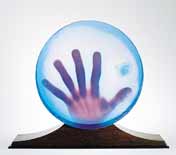
Innerspace (IS) 1983 – 1994
Develops graphite molding process and casting glasses. Makes compound cast glass pieces that compose the internal volume of solid transparent forms. Produces Innerspace series including Ascensions, Hands, Light Beams, Moons, Mountain Skyscapes, Muses, Planets and Polychrome Progressions.
Who’s hand is it?, Innerspace, IS 653, 1992, compound cast glass, cut, carved, hand polished, wenge wood and acrylic base, 12.25 x 15.9375 x 3.5 inches. Collection of the Artist. Photo: © Mark Peiser
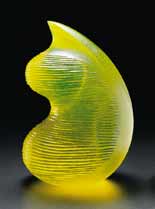
Forms of Consciousness (FOC) 1994 – 2004
Develops bottom pour casting furnace, casting and mold techniques, and glass formulae allowing larger scale work representing psychological conditions.
Anxiety, Forms of Consciousness, FOC 036•1901, 2003, cast glass, carved, hand polished, acid finish, 14.875 x 10 x 9.625 inches. Collection of the Artist. Photo: © Tom Mills
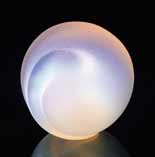
Contrition Second Study (CSS) 2000 – 2004
Produces a limited edition of 50 as a learning experience to formulate and develop casting process for controlled translucency in sculptural glass.
Contrition Second Study, Artist Proof 1, CSS 0200•1203 AP1, 2000, cast opal glass, acid finish, 6.5 x 6.5 x 7 inches. Promised gift of Ditta Weiner. Asheville Art Museum Collection. Photo: © Doug Schaible
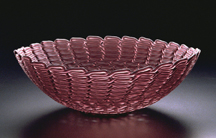
ColdStream Casting (CSC) 2001 – 2007
A creative use of my bottom pour furnace. My most fun in a glass shop since 1969. View videos of the Coldstream Casting process on You Tube by searching Mark Peiser.
Coldstream Stacked Basket, Artist Proof, Coldstream Casting, CSC 005, glass, 6.25 x 19.25 x 19.25 inches. Collection of the Artist. Photo: © Susie Silbert
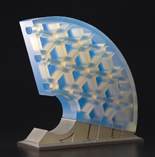
Palomar 2008 – 2012
Develops vermiculite molding process. Produces Palomar series as a tribute to the accomplishment of the Palomar Mirror in 1934. For more about the Palomar series and the transition to the Passage and Etudes Tableau, search You Tube for Mark Peiser’s Corning Museum of Glass talk.
Opening, Palomar 008, 2010, hot cast phase separated glass, acid finish, aluminum base, 27.25 x 27.25 x 10.125 inches. Collection of John Atzbach. Photo: © Steve Mann
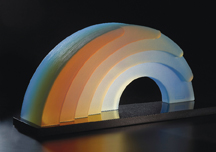
Passages and Etudes Tableau 2012 – Present
Refines formulation and heat treatment of light scattering glasses. Produces work whose subject is light.
Passage 3, 2013, hot cast phase separated glass, acid finish, aluminum base, 27.25 x 27.25 x 10.125 inches. Collection of John Atzbach. Photo: © Steve Mann
